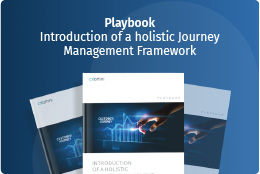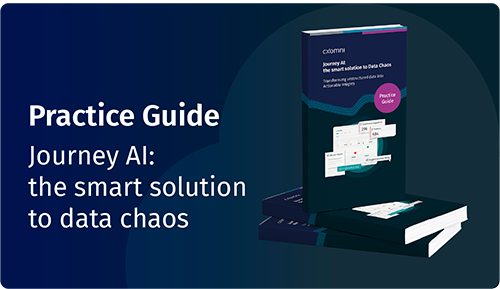Table of Contents
Customer Journey
Mapping
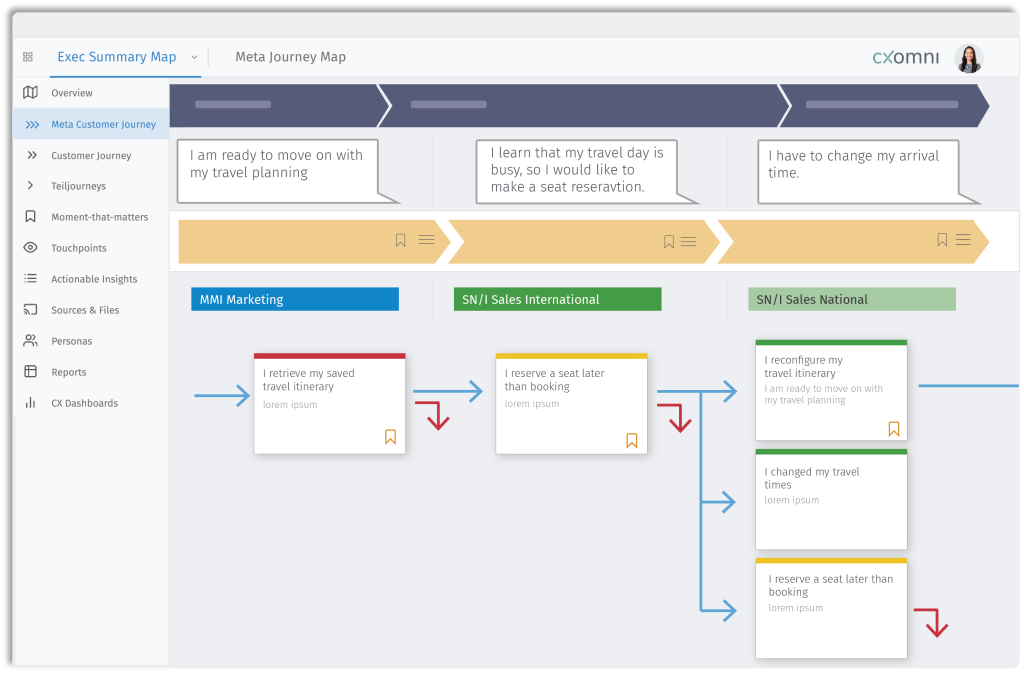
Inhaltsverzeichnis
Delighted customers genuinely recommend a product and become loyal fans of your company. These recommendations depend on touchpoints and micro-moments that work excellently, are useful to customers, and spark genuine joy—or simply function seamlessly. This encompasses marketing campaigns, sales journeys, operational journeys such as ordering and delivery, and journeys in customer service.
Increasing digitization and growing competition in many markets have made customer journeys more complex, as customers have more touchpoints with companies and see more offers. For this reason, it’s crucial for companies to understand the customer journey well from the first contact to the purchase and beyond.
Customer Journey Mapping has proven to be an effective method for visualizing and analyzing this journey. It involves identifying the various touchpoints between customers and companies and viewing them from the customer’s perspective. The goal is to better understand and improve customer emotions, expectations, and potential frustrations.
On this page, you will find a comprehensive introduction to the methodology and definition of Customer Journey Mapping. Alongside practical implementation tips, you’ll find useful information on working with templates and strategies for execution.
What is Customer Journey Mapping?
Customer Journey Mapping is a method for customer experience management. Customer journey maps help to visualize the experiences and interactions of customers with a company.
What is Customer Journey Mapping used for?
Customer Journey Mapping helps you understand your customers’ emotional experiences and expectations, enabling you to enhance their experience with targeted actions.
By integrating customer feedback data throughout your journey maps, you gain insights into what customers currently want from products and services and how they perceive each touchpoint.
This process considers various points of contact and channels, including both positive and negative experiences across touchpoints—from initial inspiration to first contact, purchase, and beyond.
In doing so, strengths and weaknesses in customer interactions with the company are identified. This insight allows you to derive actionable improvements for interactions and ultimately enhance the customer experience.
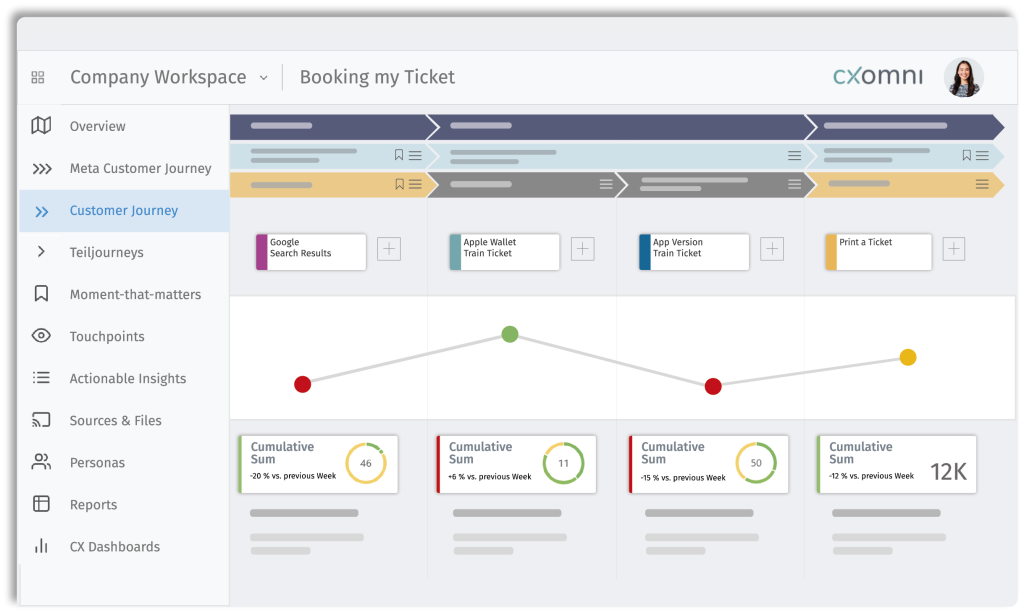
What are the goals and business impact of Customer Journey Mapping?
Customer Journey Mapping can help boost business success by placing customer-centricity at the heart of the strategy, enabling companies to develop more efficient and targeted actions for a better customer experience.
For instance, cost-saving opportunities arise when unused or underused touchpoints can be eliminated, or a channel can be shut down because satisfaction in another channel is much higher and more cost-effective. Additional goals of Customer Journey Mapping include:
- Identifying pain points in the process where customers encounter difficulties or frustrations.
- Promoting customer loyalty to build long-term relationships and enhance customer satisfaction.
- Creating more efficient processes that benefit both customers and the company.
- Aligning company strategy so that all employees work towards a consistent customer experience.
It’s important to note that these objectives vary by company or department.
What is a Customer Journey Map?
A Customer Journey Map is a type of visualization and includes all touchpoints between the customer and the company. These touchpoints can be both online (e.g. via a website, social media, emails) and offline (e.g. in-store, on the phone or in customer service conversations).
What is a Customer Journey Map used for?
Journey maps help to understand customers’ perspectives and identify optimization opportunities. This enables companies to improve customer satisfaction or enhance the effectiveness of marketing and sales strategies. Every customer journey map should therefore have a clear objective. This clarifies which insights one wants to gain.
Here’s an overview of typical objectives for a customer journey map:
- Gaining a better understanding of customer interactions and touchpoints
- Learning how customers perceive the company
- Analyzing alternative journey paths
- Taking stock of channels and evaluating the channel mix
- Validating workshop assumptions with real-time data such as NPS and CSAT
- Aligning customer interactions with company processes
How to start with
Customer Journey Mapping
Starting with Customer Journey Mapping is crucial to fully understanding and optimizing the customer experience. Begin by identifying your target audience and analyzing their needs and expectations. Then, develop personas to get a clear picture of your main customer types. Next, outline the key stages of the Customer Journey—from the first interaction to post-purchase support.
It’s essential to define each touchpoint and evaluate it from the customer’s perspective to uncover opportunities for improvement. Comprehensive Customer Journey Mapping forms the basis for data-driven optimizations and helps create a consistent and positive customer experience.

Free Customer Journey Mapping Guide
Find out what the key elements of customer journey mapping are and get plenty of practical tips to help you get started.
What are the key elements of a Journey Map?
To deliver meaningful insights, a customer journey map should include the following elements:
- Actionable Insights (Pains and Opportunities): Practical insights for journey optimization derived from data analysis and journey mapping.
- Touchpoints: A touchpoint is any point of contact where a customer interacts with a company. These interactions can be physical, digital, or offline.
- Personas: In customer journey mapping, a persona is a fictional but accurate representation of ideal customers, based on real data and market research. Personas help to understand the needs, behaviors, and goals of the target audience, shaping the journey from the customer’s perspective.
- Needs and Objectives: These include specific expectations, desires, and goals that customers have throughout their interaction with a company. Understanding these aspects helps to optimize the customer journey and achieve higher satisfaction.
- Channels: Channels are the various platforms and media through which customers interact with a company, such as websites, social media, emails, phone calls, or physical stores.
- Interactions: Interactions encompass the specific actions and communications between customers and a company at various touchpoints. These interactions influence perception and satisfaction throughout the entire journey.
- Stakeholders: Stakeholders include all individuals or groups with an interest in the design and outcome of the customer journey, such as employees from departments like marketing, sales, or customer care, as well as partners and investors.
- Responsibilities: Responsibilities are the clearly defined tasks and duties of team members or departments, ensuring each part of the customer journey is well-designed, monitored, and continuously improved.
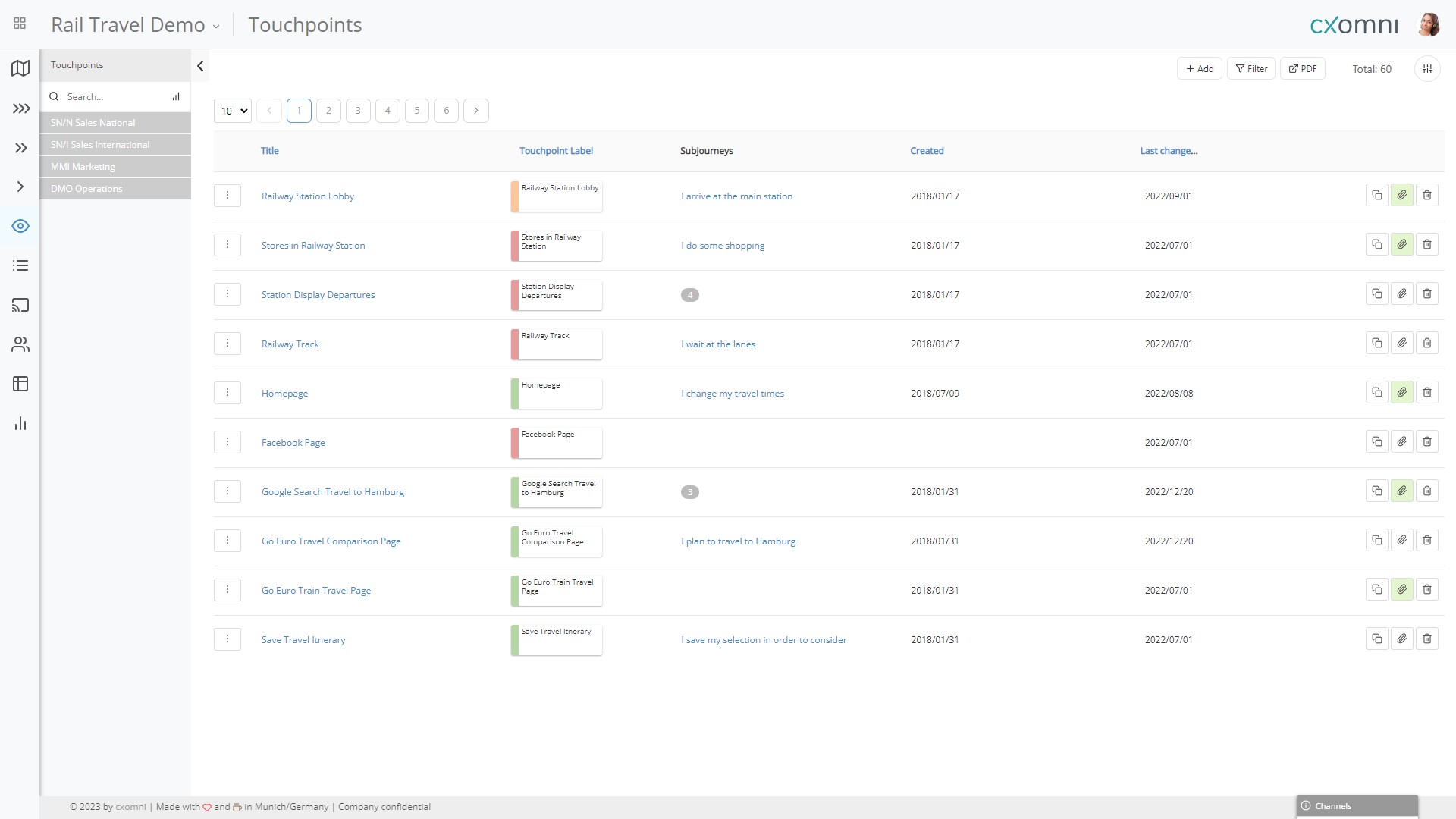
How to create a Customer Journey Map?
The key to successful Customer Journey Mapping lies in defining its purpose. CX teams should align on the purpose of the Customer Journey Mapping and clarify the desired outcomes. This ensures that insights from the mapping process lead to effective actions.
Possible questions include: Are we investigating reasons for customer dissatisfaction at a touchpoint? Or is the goal to develop actions that improve conversions and increase revenue? This phase sets the stage for the business impact of Customer Journey Mapping.
Next, determine if the company has a template approach, such as existing elements like personas or individual journeys, to facilitate mapping. Leveraging existing journey components can speed up the process and avoid starting from scratch.
If the company already uses journey-mapping solutions, AI-based assistants can help create the journey map, depending on the tool. For example, an AI assistant might suggest initial journey structures and explain steps in the customer journey based on the use case, creating a rough draft that can then be refined with specific touchpoints or subjourneys.
Of course, AI assistants (currently) do not deliver complete journey maps. Customizing the map to fit the predefined goals remains essential.
Once the foundational structures of the Customer Journey Map are defined, personas can be developed. Creating personas involves collecting and analyzing customer data to form fictional characters that represent typical customer profiles. These personas include demographic information, behavior patterns, needs, goals, and challenges.
Interviews, surveys, and customer feedback analyses can enrich this data, enhancing understanding of the various journey phases and making it easier to identify touchpoints and pain points.
Next, the swimlanes of the Customer Journey Map can be established and populated. Swimlanes contain detailed information for a specific journey phase and objective, such as needs, touchpoints, or actionable insights. They may also include emotion curves reflecting customer experiences or text fields that describe needs or behaviors.
After setting these parameters, the mapping participants are selected, comprising employees and stakeholders who will contribute to the Customer Journey Mapping. It’s essential to assign responsibility for each journey phase to the relevant department, and all key departments should participate for a complete picture of the journey.
Customer Journey Mapping is usually collaborative since customer journeys often span multiple departments or channels. For example, some journeys may start offline, with a customer visiting a store, and end online, with a purchase on the company’s website.
Once these preliminary steps are completed, the actual mapping begins, typically using software solutions that visualize customer journeys and incorporate data from various sources (e.g., CRM systems, surveys, web analytics) to give CX teams a holistic view of the customer experience.
During the mapping, each touchpoint and journey phase is enriched with relevant information about the customer experience, such as:
- Customer activities
- Customer emotions
- Challenges & pain points
- Opportunities for improvement
- Customer quotes & feedback
- KPIs and metrics
Depending on the software, customer feedback and KPIs such as NPS or CSAT can be integrated in real-time. Most customer journey mapping tools are collaborative, allowing cross-departmental teams to share insights and develop solutions together.
Integrated reporting functions enable the creation of reports and dashboards, helping CX teams track progress in Customer Journey Mapping. It is crucial to present results in a way that is relevant to each stakeholder group: CX teams should select a view that transparently shows only the relevant findings, preserving important insights and enabling stakeholders to focus on implementing appropriate actions.
For instance, management teams are often interested in the current level of customer satisfaction, while operational teams are more concerned with identifying causes of problems or opportunities for improvement.
How to work with Customer Journey Templates
Many software providers offer integrated industry templates—pre-built, generic customer journeys like a contract cancellation journey for insurance companies. These templates make it much easier to get started with customer journey mapping.
Typically, these templates include the initial steps of a journey, and companies can quickly expand and tailor them to their needs.
Customer journey templates also bring the advantage of standardized content, covering personas, touchpoints, and journey phases.
By using templates, companies ensure a consistent format, with all customer journeys following the same rules and methods. This consistency improves comparability and helps highlight differences across customer segments, products, or services.
CX teams, however, should make sure each template fits their objectives. A template should provide a certain level of standardization but still allow enough flexibility for CX teams to work effectively.
Despite these benefits, customer journey templates have limitations as well.
Software providers usually design customer journey templates from a strategic perspective, which means CX teams must adapt them to the specific structures and workflows within their organization.
A “one-size-fits-all” template simply doesn’t exist, so CX teams should look for customer journey templates with a high degree of customization.
One way to personalize templates is by setting up a unique framework. Taxonomies, terminologies, and information hierarchies for customer journey mapping differ across companies, so it’s essential to define them beforehand.
To create a consistent standard for everyone involved in the mapping process, CX teams should also adapt framework content within industry templates. Only then can companies create customer journeys consistently and compare results effectively.
Overly rigid templates can limit flexibility in day-to-day implementation. Often, journey standards don’t align perfectly with each organization. For example, teams may need to add or remove touchpoints and channels in the template to match the specific needs of their business area.
10 best practices for Customer Journey Mapping
- Defining the goal should always come first. Ideally, CX teams gain valuable insights through customer journey mapping, which helps assess the performance of the customer journey. It also reveals ways to sustainably improve the customer experience. This might involve analyzing the customer journey for a new service offering, for example. A customer journey map without a clear goal is just a nice illustration of customer experiences but has no impact on the business.
- Customer Journey Mapping should involve cross-departmental collaboration. A journey map is most valuable when it is created collaboratively, not in isolation. It’s essential to involve stakeholders from the start, as they will later be responsible for implementing the action steps. This way, insights and tasks can be developed and assigned collectively. Moreover, different departments can collaboratively document insights into customer behavior within the journey map, bringing in a variety of perspectives.
- Continuous updates to the Customer Journey Map are essential. A customer journey map is a constantly evolving process. Key reasons for updates include new behaviors among the target audience and continuous insights provided by real-time data, such as customer feedback and satisfaction scores. As insights and journey performance change, ongoing monitoring is required.
- Software tools support the continuous nature of Customer Journey Mapping. Using software is beneficial, as it allows updates to be documented much more flexibly and quickly than static journey mapping on a whiteboard.C
- Companies should define their touchpoints clearly to simplify operational work. For example, in an online journey, Google itself is not a touchpoint; rather, the search term a customer enters or the Google ad that generates a conversion is the touchpoint. Each interaction offers specific insights, and the impact on the customer experience must be assessed differently. For instance, Google keywords may need optimization, while the ad’s message may need adjusting to better appeal to customers.
- The responsibilities of all involved in Customer Journey Mapping should be clarified and defined. Since CX teams often act as control hubs, they are not responsible for implementing actions; they need accountable stakeholders. These stakeholders are expected to bring insights from the customer journey into their departments and initiate improvements. Ideally, responsibilities are assigned to a specific person, but they are generally managed at the department level. This task distribution ensures that CX improvements do not get stuck within silos but are implemented and monitored. For instance, if UX issues are identified on the website during customer journey mapping, they must be addressed by the design team in marketing rather than the CX team, as this aligns with organizational responsibilities.
- Customer Journeys should not be viewed as strictly linear. In today’s digital world, consumers have multiple touchpoints and options to interact with companies, both online and offline. This allows customers to start, pause, and resume their journeys in different phases. They may transition between various phases like information gathering, evaluation, and purchasing decisions. Furthermore, they interact with companies via websites, social media, emails, stores, and customer service, each providing unique experiences. Personalization also plays a key role, as individual preferences influence the journey, meaning not every customer experiences the same journey. These variations should also be considered in customer journey mapping.
- Customer Journey Maps should be dynamic. Even after completing a customer journey map, there are always remaining questions and goals that aren’t included in the map. Journey maps should therefore be designed to allow for subsequent adjustments. With increasing digitalization, new touchpoints are constantly emerging along the journey, and customer demands and behaviors are ever-evolving.
- Static Customer Journey Mapping has limitations. This is due to the changing nature of customer demands. Updating journey maps in whiteboard tools is time-consuming, as they are saved as individual files rather than being organized within a database structure. Dynamic customer journey maps offer the advantage of being viewed from different angles. Depending on the software, information can be filtered by objective, context, or stakeholder presentation. In complex journeys, users can hide non-essential information, allowing them to focus on the relevant parts of the map.
- Customer Journey Maps should always be documented from the customer’s perspective. This makes customer journey mapping more than just a process visualization. Journey steps should always be documented using “I” statements and the corresponding activity. This helps users adopt the customer’s perspective, understanding their thoughts and feelings. The “I” perspective aids in identifying problems and pain points in the customer journey, making it easier to find targeted solutions to improve the customer experience.
Creating uniform Customer Journey Mapping standards with Journey Management Frameworks
When different departments participate in journey mapping or teams collaborate, all stakeholders should share a unified understanding and use consistent terminology.
This includes a standardized taxonomy for structuring journeys and touchpoints, along with clear terminology for labels and key concepts. In cxomni, companies standardize these guidelines with unified templates and establish them as a company-wide framework. This foundation supports comprehensive customer journey management and a needs management strategy closely integrated with product management.
To keep all customer journey management processes efficient and scalable, it’s essential to continuously maintain and develop this framework. Doing so requires an integrated governance model that both incorporates input from various departments and adapts to evolving customer needs. Regular reviews ensure that taxonomy and templates remain consistent even as strategic priorities shift or new product innovations emerge.
A holistic approach to journey mapping also helps break down silos in large organizations. When all teams—from marketing and sales to service—have a central, visual reference for customer interactions, collaboration strengthens, and valuable synergies develop. This approach not only enhances the user experience but also enables the seamless integration of customer feedback and performance data, driving continuous improvement in customer journeys.
Studies also show that customer journey mapping and the resulting improvements in customer experience are increasingly crucial to business success: For instance, companies with a strong focus on CX have achieved revenue increases of up to 80%.
How to enrich Customer Journey Mapping with data insights
To gain authentic journey insights, CX teams can enhance touchpoints with real-time data from web analytics, surveys, or CRM transactions, using these data points to model and analyze customer journeys. This approach allows CX teams to assess critical connections between product requirements, journey stages, experience context, and customer needs.
In cxomni, teams manage these data insights in fully configurable journey dashboards. Departmental CX leaders can then combine and access sentiment-analyzed feedback, CSAT trends, or KPIs reflecting the current state of customer satisfaction.
AI Solutions: smart and efficient Customer Journey Mapping with Journey AI
Artificial Intelligence (AI) is becoming increasingly important and has the potential to simplify and enhance Customer Journey Mapping. The AI-powered solution Journey AI by cxomni can analyze complex datasets in real time, seamlessly integrate user interactions, and provide businesses with profound insights into the customer journey.
How AI-Powered Customer Journey Mapping Works in Practice
- Automated Touchpoint Analysis:
Journey AI can automatically aggregate and analyze data from sources like social media, CRM systems, and web analytics. For example, a retailer might discover that potential customers frequently drop off during the checkout process. Based on historical data and behavioral patterns, the AI suggests optimization measures to address this weakness. - Sentiment Analysis for Better Decisions:
Businesses use Journey AI to analyze customer feedback in real time. For instance, a telecommunications provider might use sentiment analysis to identify that most complaints stem from long wait times in customer service. This insight allows the provider to implement targeted improvements to their support processes. - Resource-Efficient Customer Journey Mapping:
An insurance company planning a new online service portal wants to test its user-friendliness before launch. The team creates a preliminary customer journey map to visualize how the portal will be used. Based on the company’s previously recorded journeys, Journey AI automatically suggests the next logical journey step during mapping. This speeds up the map creation process and ensures logical adjustments.
Key features of Journey AI at a glance
AI Journey Mining:
Automatically creates journeys from unstructured data such as customer feedback and web analytics. This feature identifies emotional highs and lows, weaknesses, and opportunities along the journey.Insights Mining:
Detects patterns and trends in unstructured data sources like support tickets or chat logs. This enables a deeper analysis of customer needs and market potentials.Sentiment Analysis and Thematic Clustering:
Quickly categorizes and visualizes customer feedback to reveal pain points, positive experiences, and areas for improvement.
Benefits for your Customer Journey Mapping
These features help businesses optimize their customer journey mapping in two key ways. On the one hand, seamless data integration provides deeper insights into customer behavior and needs. On the other hand, AI helps CX teams save valuable time and resources during mapping, allowing them to focus more on analyzing insights and developing improvement measures.
Summary: the key benefits of AI in Customer Journey Mapping
- Automation and Efficiency: AI technologies handle complex tasks that traditionally require significant time and manual effort. By automating processes like data aggregation and analysis, companies can save resources and focus on core strategic tasks.
- Data Integration: AI solutions unify data from various sources such as CRM systems, social media platforms, and web analytics tools. This integration provides a comprehensive view of the entire customer journey by breaking down isolated data silos. Companies gain a consolidated overview of all customer interactions.
- Real-Time Monitoring: Companies can make proactive decisions based on current insights. For example, trends or weaknesses in customer behavior can be identified early and addressed effectively.
- Personalization: AI identifies individual customer preferences, needs, and behavioral patterns. These insights enable companies to create tailored experiences and offers that enhance customer loyalty and satisfaction.
- Predictive Analytics: Using machine learning, AI analyzes historical data and generates forecasts for future customer needs and behaviors.
- Better Decision-Making: Data-driven insights help executives make strategic decisions in a well-founded and targeted manner. This transparency improves the prioritization of actions and increases the likelihood of achieving desired business outcomes.
- Cost Savings: Automated processes reduce the need for manual analyses, which are time- and labor-intensive. This not only saves costs but also improves the accuracy of analyses by minimizing human errors.
With Journey AI, the complexity of the customer journey — especially managing multiple complex journeys — becomes manageable through innovative technology. This helps companies enhance customer satisfaction and ensure long-term business success.

Get your free Customer Journey Mapping Guide
Find out what the key elements of customer journey mapping are and benefit from many practical tips.
Further contents
Customer Journey
Mapping Guide
Find out what the key elements of customer journey mapping are and benefit from many practical tips for your start.
Success Story: Generali Switzerland
Find out how leading insurance company Generali was able to significantly reduce the time required to implement CX improvements.
Success Story: Unite
Learn more about the introduction of the Customer Journey Management Framework for the e-procurement platform Unite.


